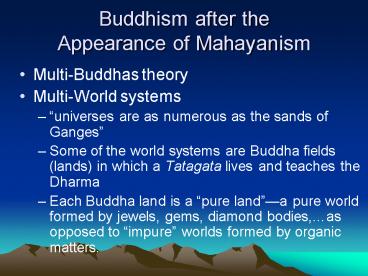Buddhism after the Appearance of Mahayanism - PowerPoint PPT Presentation
1 / 18
Title:
Buddhism after the Appearance of Mahayanism
Description:
Buddhism after the. Appearance of Mahayanism. Multi-Buddhas theory. Multi-World systems 'universes are as numerous as the sands of Ganges' ... A New Form of Buddhism? ... – PowerPoint PPT presentation
Number of Views:73
Avg rating:3.0/5.0
Title: Buddhism after the Appearance of Mahayanism
1
Buddhism after the Appearance of Mahayanism
- Multi-Buddhas theory
- Multi-World systems
- universes are as numerous as the sands of
Ganges - Some of the world systems are Buddha fields
(lands) in which a Tatagata lives and teaches the
Dharma - Each Buddha land is a pure landa pure world
formed by jewels, gems, diamond bodies,as
opposed to impure worlds formed by organic
matters.
2
Better-Known Buddha Lands
- Abhirati, Land of Light in the East, presided by
the Buddha Aksobhya, which means immovable or
imperturbable - This pure land and the Buddha Aksobhya are not
popular in East Asia, but are relatively popular
in Tantrism - In art, he is represented in blue, holding a
diamond in his right hand his left hand is in
the earth-witness gesture, with a blue elephant
for his mount.
3
The Buddha Aksobhya
4
- Sukhavati, Land of Utmost Bliss in the West,
presided by the Buddha Amitabha (Amitayus), which
means immeasurable light/life span - Story about this Buddha
- Found in the Longer/Larger Sutra (one of the
three major Pure Land Sutras) - Amitabha song 1
- Amitabha song 2
5
Three Pure Land Sutras
- The Shorter/Smaller Sutra on Amitayus, The
Longer/Larger Sutra on Amitayus, The Sutra on
Contemplation of Amitayus - Amitayus (The Buddha of Infinite life) or
Amitabha (The Buddha of Immeasurable Light) - O-mi-to fo, Wu-liang-shou fo (Chinese)
- Amida (Japanese)
- Pure Land (Sukhavati)the Land of Utmost Bliss
6
Amitayu
Amitabha
7
A New Form of Buddhism?
- Early Mahayanists and Hinayanists saw problems of
a new movement in Buddhist communities the
emergence of the Pure Land and the Amitabha cult - It is an aberration from the Buddhas original
intention, because it no longer follows the
Buddhas path self-reliance, strict ethical,
mental, and spiritual disciplines - Rather, is stresses the worship of the Buddha
Amitabha and the reliance on his saving
graceputting ones faith in a powerful other.
8
Self-power vs. Others Power
- What caused the shift from self-discipline to
reliance on others saving grace, and from
reliance on austerity/effort to reliance on
faith? - The Three Stages/Periods Dharma theory
- The Period of the True Dharma (Zhengfa), 500
years - The Period of the Outer-Semblance (Xiangfa) of
the Dharma, 1,000 years - The Period of the Decay of the Dharma (Mofa),
10,000 years
9
The Shorter/Smaller Sutra
- Chinese translation was done by Kumarajiva
(344-413) - Great translator of Buddhist scriptures from
Kucha - Arrived in China in 401
- Translated 74 scriptures in 384 fascicles in
total, including - the Diamond Sutra
- the Lotus Sutra
- the Amitabha Sutra
10
- Major Discourse--four parts
- Shakyamuni describes the land of Utmost Bliss and
its presiding buddha, the Buddha Amitabha
(Amitayus) - He names some of the buddhas in other worlds who
confirm the truth of his message as they praise
the virtue of Amitayus - He explains the nature of the trust and
commitment required for rebirth in the Land of
Utmost Bliss - He explains how difficult it is to attain
buddhahood and preach the message of the sutra
11
- Narrative structure--several voices
- Ananda (narrator)
- an audience of thousands of monks, arhats,
bodhisattvas. - Shariputra (a stand-in for the sutras readers
or audiences) - Shakyamuni
- Amitayus himself and the inhabitants of his Land
12
Pure Land according to the Smaller (Shorter)
Sutra
- Dwellers
- suffer no pain, but enjoy pleasures of various
kinds - exquisite flowers offered to numerous buddhas
- dwell in a stage of Non-retrogression
- Nature scene
- seven-jeweled ponds with water of eight excellent
qualities - beautiful, fragrant, and pure lotus in the ponds
- Heavenly flowers rain down from the sky
13
A World of Gold and Gems
- Constructions
- Seven rows of balustrades, decorative nets, and
trees - all made of four kinds of jewels
- Pavilion adorned with seven jewels (gold, silver,
beryl, crystal, sapphire, rosy pearls, and
cornelian)
sapphire
cornelian
14
A World of Harmonious Music and Sounds
- Heavenly music
- Sounds sung by
- Rare and beautiful birds of various colors
- white geese, peacocks, parrots
- Sound generated by soft breezes wafting through
the jeweled trees and nets - People are spontaneously mindful of the Buddha
when hearing the sounds
15
Pure Land of the West, anonymous, Tang Dynasty
(618-905), from the Dunhuang Caves
16
Pure Land of the West, Anonymous, Tang Dynasty,
from the Dunhuang Caves
17
Rebirth in Amitayus land
- A different type of rebirth
- Suffer no more, enjoy endless bliss
- Enjoy immeasurable life span
- This birth/rebirth gives one a better chance to
enter nirvana
18
Faith and Rebirth
- To attain rebirth in this Pure Land, one must
- accept this sutra
- cultivate faith in Amitayus and His Pure Land
- accept the notion of the Pure Land with trust and
without question - aspire to the rebirth in Amitayus land of
ultimate bliss. - hold fast to Amitayus name after hearing it
- The state of deliverance
- at death, Amitayus will appear with other holy
ones - aspirants mind will not fall into confusion
- aspirant will be born in Amitayus land































